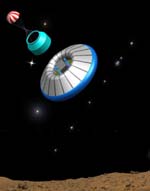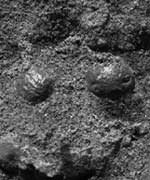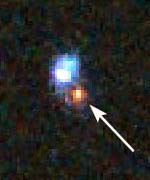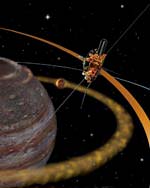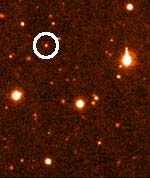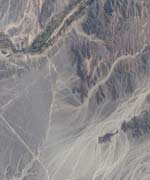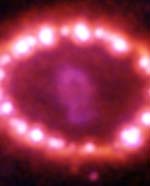
Image credit: NASA
If alien astronomers around a distant star had studied the young Sun four-and-a-half billion years ago, could they have seen signs of a newly-formed Earth orbiting this innocuous yellow star? The answer is yes, according to Scott Kenyon (Smithsonian Astrophysical Observatory) and Benjamin Bromley (University of Utah). Moreover, their computer model says that we can use the same signs to locate places where Earth-size planets currently are forming-young worlds that, one day, may host life of their own.
The key to locating newborn Earths, say Kenyon and Bromley, is to look not for the planet itself, but for a ring of dust orbiting the star that is a fingerprint of terrestrial (rocky) planet formation.
“Chances are, if there’s a ring of dust, there’s a planet,” says Kenyon.
Good Planets Are Hard To Find
Our solar system formed from a swirling disk of gas and dust, called a protoplanetary disk, orbiting the young Sun. The same materials are found throughout our galaxy, so the laws of physics predict that other star systems will form planets in a similar manner.
Although planets may be common, they are difficult to detect because they are too faint and located too close to a much brighter star. Therefore, astronomers seek planets by looking for indirect evidence of their existence. In young planetary systems, that evidence may be present in the disk itself, and in how the planet affects the dusty disk from which it forms.
Large, Jupiter-sized planets possess strong gravity. That gravity strongly affects the dusty disk. A single Jupiter can clear a ring-shaped gap in the disk, warp the disk, or create concentrated swaths of dust that leave a pattern in the disk like a wake from a boat. The presence of a giant planet may explain the wake-like pattern seen in the disk around the 350 million-year-old star Vega.
Small, Earth-sized worlds, on the other hand, possess weaker gravity. They affect the disk more weakly, leaving more subtle signs of their presence. Rather than looking for warps or wakes, Kenyon and Bromley recommend looking to see how bright the star system is at infrared (IR) wavelengths of light. (Infrared light, which we perceive as heat, is light with longer wavelengths and less energy than visible light.)
Stars with dusty disks are brighter in the IR than stars without disks. The more dust a star system holds, the brighter it is in the IR. Kenyon and Bromley have shown that astronomers can use IR brightnesses not only to detect a disk, but also to tell when an Earth-sized planet is forming within that disk.
“We were the first to calculate the expected levels of dust production and associated infrared excesses, and the first to demonstrate that terrestrial planet formation produces observable amounts of dust,” says Bromley.
Building Planets From The Ground Up
The most prevalent theory of planet formation calls for building planets “from the ground up.” According to the coagulation theory, small bits of rocky material in a protoplanetary disk collide and stick together. Over thousands of years, small clumps grow into larger and larger clumps, like building a snowman one handful of snow at a time. Eventually, the rocky clumps grow so large that they become full-fledged planets.
Kenyon and Bromley model the planet formation process using a complex computer program. They “seed” a protoplanetary disk with a billion planetesimals 0.6 miles (1 kilometer) in size, all orbiting a central star, and step the system forward in time to see how planets evolve from those basic ingredients.
“We made the simulation as realistic as we could and still complete the calculations in a reasonable amount of time,” says Bromley.
They found the planet formation process to be remarkably efficient. Initially, collisions between planetesimals occur at low velocities, so colliding objects tend to merge and grow. At a typical Earth-Sun distance, it takes only about 1000 years for 1-kilometer objects to grow into 100-kilometer (60-mile) objects. Another 10,000 years produces 600-mile-diameter protoplanets, which grow over an additional 10,000 years to become 1200-mile-diameter protoplanets. Hence, Moon-sized objects can form in as little as 20,000 years.
As planetesimals within the disk grow larger and more massive, their gravity grows stronger. Once a few of the objects reach a size of 600 miles, they begin “stirring up” the remaining smaller objects. Gravity slingshots the smaller, asteroid-sized chunks of rock to higher and higher speeds. They travel so fast that when they collide, they don’t merge-they pulverize, smashing each other apart violently. While the largest protoplanets continue to grow, the rest of the rocky planetesimals grind each other into dust.
“The dust forms right where the planet is forming, at the same distance from its star,” says Kenyon. As a result, the temperature of the dust indicates where the planet is forming. Dust in a Venus-like orbit will be hotter than dust in an Earth-like orbit, giving a clue to the infant planet’s distance from its star.
The size of the largest objects in the disk determines the dust production rate. The amount of dust peaks when 600-mile protoplanets have formed.
“The Spitzer Space Telescope should be able to detect such dust peaks,” says Bromley.
Currently, Kenyon and Bromley’s terrestrial planet formation model covers only a fraction of the solar system, from the orbit of Venus to a distance about halfway between Earth and Mars. In the future, they plan to extend the model to encompass orbits as close to the Sun as Mercury and as distant as Mars.
They also have modeled the formation of the Kuiper Belt-a region of small, icy and rocky objects beyond the orbit of Neptune. The next logical step is to model the formation of gas giants like Jupiter and Saturn.
“We’re starting at the edges of the solar system and working inward,” Kenyon says with a grin. “We’re also working out way up in mass. The Earth is 1000 times more massive than a Kuiper Belt object, and Jupiter is 1000 times more massive than the Earth.”
“Our ultimate goal is to model and understand the formation of our entire solar system.” Kenyon estimates that their goal is attainable within a decade, as computer speed continues to increase, enabling the simulation of an entire solar system.
This research was published in the February 20, 2004, issue of The Astrophysical Journal Letters. Additional information and animations are available online at http://cfa-www.harvard.edu/~kenyon/.
Headquartered in Cambridge, Mass., the Harvard-Smithsonian Center for Astrophysics is a joint collaboration between the Smithsonian Astrophysical Observatory and the Harvard College Observatory. CfA scientists, organized into six research divisions, study the origin, evolution and ultimate fate of the universe.
Original Source: CfA News Release


